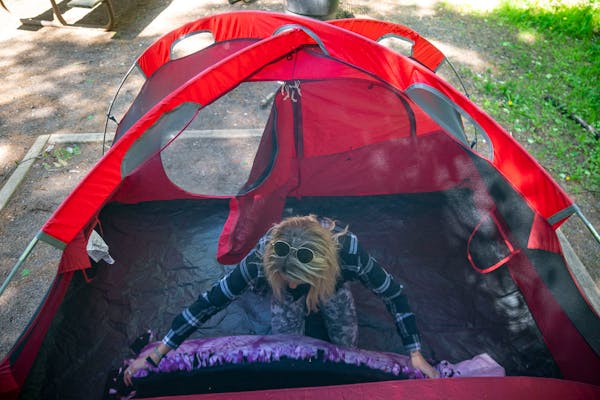A light bulb went off in in my head a few months back while I was shedding myself of some unneeded camping gear. Perhaps I should say dots were connected. Or maybe a light bulb went off, connecting dots.
Either way, it, or these, occurred while I watched a Cub Scout mom weigh the merits of a tent I was selling.
"Forty bucks?"she huffed.
"A bargain at twice the price," I said.
The tent was well-traveled. I had camped in it in the boundary waters, in South America and a lot of places in between. Faded from its original forest green, it was heavy by modern backpacking standards and the rain fly wasn't as water resistant as it once was.
But the mosquito netting was intact. As was the floor. New, it would set the bargain-hunting Den Mother back $200, at least.
"Give me $25 and I'll throw in some camp cookware," I said.
"Twenty."
"Deal."
Watching the woman disappear down my driveway, the light bulb illuminating my noggin grew only brighter, connecting the aforementioned dots and affirming my long-held belief that most outdoor gear, purchased new, is for many people prohibitively expensive.
Yet largely unknown to many of these would-be campers, backpackers, hikers, and anglers is that used equipment can sometimes be bought for a song — or at least for significantly less than new.
Gore-Tex raincoats are one example of the big bucks some new outdoor gear items command — as much as $400 in some cases. Canoes, backpacks, tents and specialty cook stoves can be pricey, too.
Among my friends, the most cost-conscious — OK, cheap — gear buyer is Wendell Diller.
Neither rich nor poor but somewhere in between, Wendell prefers, if he can, to make a piece of gear or clothing. Failing that, he'll buy used, if possible — and it almost always is.
"I grew up in a Mennonite family in Oregon," Wendell said. "My dad was a pastor and every Sunday in church, or many Sundays, I would hear sermons about the value of thrift. I guess it stuck. My 'camping car' is a rust-free 1996 Olds 98 with the backseat removed for gear storage. My wife and I bought our refurbished Kevlar canoe used in the offseason. And virtually all of our camping and other outdoor clothing we buy at secondhand stores."
How much can you save buying used outdoor equipment rather than new? A mini-Weber grill was listed on Craigslist this week in Isanti for $10. An Igloo marine-quality 72-quart cooler? Thirty bucks in Hopkins. Dry bags for hiking, camping or canoeing in various sizes that sell for $25-$40 new? Take your pick: $9.95-$12.95, also on Craigslist.
"It's a myth perpetuated by many clothing and equipment manufacturers that you have to spend a lot of money to have a good time outdoors," said Nancy Ford, owner of a shop called Repair Lair (repairlair.com) on Lake Street in Minneapolis.
Specializing in secondhand outdoor clothing and gear, Ford also is a master repair person, patching and sewing clothing for customers and to resell in her shop.
"My introduction to camping was in high school through a St. Paul Public Schools summer program," said Ford. "I remember taking a four-day backpacking trip in northern Minnesota, followed by a monthlong backpacking trip in the Canadian Rockies that cost me $70, total. We had no stoves, no water purifiers, we drank powered milk and ate government surplus food. But we had fun."
Ford managed the Thrifty Outfitters outdoor gear repair department at Midwest Mountaineering in Minneapolis before opening the Repair Lair in 2014. She sold consignment outdoor gear in her shop until the pandemic hit, splitting proceeds with the owners 50-50. Now, instead, she buys select clothing and gear brought to her, repairing it if necessary and placing it in her 1,400-square-foot outlet for resale.
"When I was a teenager I'd go to thrift stores looking for clothing," she said. "Then I started buying clothing for friends, and after that, looking for stuff to resell at consignment shops. For my friends and me it became a social activity. That's how I acquired a deep knowledge of how to price secondhand goods. It's also what prompted me to open my business when I realized there was nothing like that for outdoors gear and clothing."
For newcomers to camping and other outdoor activities, renting gear is another option. Among Twin Cities outlets (search online for more) that rent gear is the Center for Outdoor Adventure near the University of Minnesota campus (tinyurl.com/euvdweed), which rents to the general public as well as students.
Sample three-day prices include $40 for a six-person tent, $14 for a three-season sleeping bag, $90 for an ultralight canoe and $70 for a mountain bike.
A caveat to this rent-or-buy-used-and-enjoy-just-as-much-as-new outdoor-gear philosophy is that for some activities pursued frequently, high-quality gear is, if not a must, at least desirable.
If you paddle a lot, for example, a 50-pound canoe is always going to be more comfortable to portage than a 60-pounder. But you'll have to save up. New, a quality lightweight two-ender might set you back $3,200.
On the other hand, on Craigslist this week, a guy in St. Louis Park was selling a 17-foot-long, 50-pound canoe for $1,300.
Bargain like a Cub Scout Den Mother, and you might buy it for less.

Anderson: Celebrate Earth Day by rekindling real connection to nature
Anderson: Anglers protesting tough new Mille Lacs rules are wrong

Anderson: Courts, not politicians, should rule on Red Lake, White Earth lands

Anderson: Multimillion windfall gets invasive carp deterrent moving
![A young whitetail deer searches for food as another blanket of snow coats the arrowhead. ] Minnesota -State of Wonders, Arrowhead in Winter BRIAN PETE](https://arc.stimg.co/startribunemedia/WK32UWWY6FKNWJUIYCJ6ZPT4AU.jpg?h=91&w=145&fit=crop&bg=999&crop=faces)




